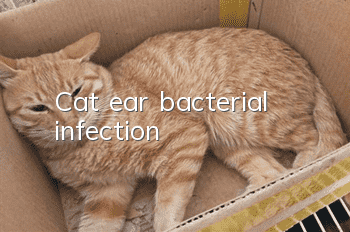Cat ear bacterial infection

Symptoms of bacterial infection in cat ears:
1. Bacterial infection in cat ears can cause hearing loss or even deafness in cats. Compared with ear mites, fungi are not itchy or It doesn't stink when scratched, the ear canal is moister, the ear oil is large, and the dirt is obviously flaky and dry.
2. Most cases are parasitic in the ear canal, and a few cases also appear in the head, neck and tail. It is usually concentrated in the ear canal, head and neck. In severe cases, itching may occur all over the body. Ear itching is manifested by scratching the ears with hind legs or shaking the head.
3. Reddish-brown or black ear canal secretions are produced, consisting of ear oil, blood, inflammatory secretions and ear mites themselves. There are scratches on the skin, which will appear near the ears, the neck and the base of the tail, etc.
4. The cat has ear pain and refuses ear canal examination. Hair removal on the outside of the auricle. May cause ear hematoma. Severe cases can cause otitis media or otitis interna, which may cause hearing loss, loss of balance and other symptoms.
Treatment methods for bacterial infection of cat ears:
1. For otitis externa caused by bacterial infection in cats, you can first use Erjia Fen Ear Care Solution to clean the ears, which can provide deep cleaning. It can control the symptoms of cat ear infection and odor in cats' ear canals. It also has certain antibacterial and anti-inflammatory properties to promote healthy ear canal skin.
2. If your cat’s ears are smelly, red, swollen, or have exudate, you need to use chlorfenicol and metronidazole ear drops. Its main function is to sterilize and prevent corrosion, eliminate epidermal inflammation, and target bacteria in the cat’s ears. Otitis externa and otitis media caused by infection.
3. To eliminate bacteria in the body, it is necessary to use cefadroxil tablets for anti-inflammatory and sterilization. It is very effective for symptoms such as redness, swelling, and pus discharge in the cat’s ears. It can remove the bacteria more thoroughly and avoid continued infection of the cat’s ears.
- Why do cats have white bugs on their butt?
- Is it okay if alcohol is sprayed on a cat?
- How to feed pet cats and what to eat? Cat and dog food formula ratio
- Why does the female cat keep meowing?
- What causes cataracts in cats
- What should I do if my child is scratched by a cat and bleeds?
- Why does the cat sigh?
- How old is a cat before it can be bathed?
- Will gold gradient female cats have gills?
- Can cats be dewormed and vaccinated at the same time?



